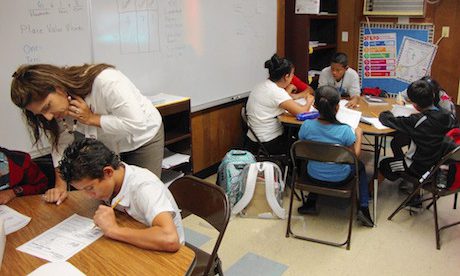Gaspar Marcos stepped off the 720 bus into early-morning darkness in MacArthur Park after the end of an eight-hour shift of scrubbing dishes in a Westwood restaurant.
He walked toward his apartment, past laundromats fortified with iron bars and scrawled with graffiti, shuttered stores that sold knockoffs and a cook staffing a taco cart in eerie desolation. Around 3 a.m., he collapsed into a twin bed in a room he rents from a family.
Five hours later, he slid into his desk at Belmont High School, just before the bell rang. The 18-year-old sophomore rubbed his eyes and fixed his gaze on an algebra equation.
Minutes ticked by, and others straggled into the class, nine in all. Like Marcos, most had worked a full shift the night before — sewing clothes, cooking in restaurants, painting homes.
Most were immigrants from Central America, part of several waves of more than 100,000 who arrived as children in the U.S. in the past five years without parents, often after perilous journeys.
Many ended up in classrooms throughout the country. In Los Angeles’ Belmont High, nearly 1 in 4 of the school’s estimated 1,000 students came from Central America — many of them as unaccompanied minors.
They crossed the border to reunite with mothers and fathers or to find refuge from unprecedented gang violence at home. Some dare to dream they will find success in America, not just the means to survive.
Belmont Principal Kristen McGregor said it has forced the school to reimagine its role in its students’ lives.
“Our students, a lot of them have to work. A lot of them have to send money home or pay for rent,” she said. “This is going to take a rethinking of education in general. Sure, they get into school, but what’s next? How do we support them?” Continue reading
Sources
- Article by Cindy Carcamo, who covers immigration issues for the Los Angeles Times
- Image: Los Angeles Times
